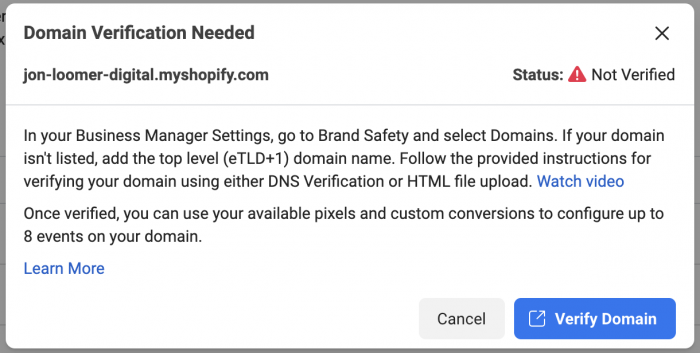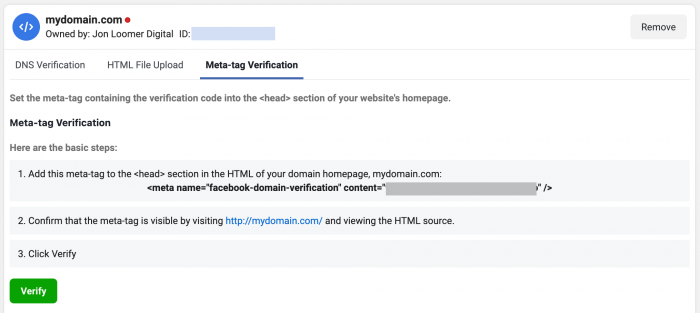Back in February, I covered the challenges facing different types of businesses when it comes to domain verification, the 8-event limit, and conversion optimizationThe Performance Goal is chosen within the ad set and determines optimization and delivery. How you optimize impacts who sees your ad. Meta will show your ad to people most likely to perform your desired action. More. It looks like there may be a glimmer of hope for some e-comm businesses, particularly those using Shopify.
Understand that this entire situation is fluid. Facebook established Aggregated Event MeasurementAggregated Event Measurement is Meta's protocol for handling tracking opt-outs from iOS devices. AEM initially required advertisers to configure and rank eight events and verify their website, but those requirements were removed in 2023. Aggregated Event Measurement still exists, but Meta handles it on the back-end to comply with Apple requirements on privacy. More, the 8-event limit, and other protocols in response to iOS 14 and privacy rules related to tracking. Facebook’s actions have been largely reactionary, and we should expect many changes and adjustments as we go.
One specific challenge that these new protocols created was related to businesses that sell on a website that they do not own or control. Such businesses would not be able to verify the domain where these transactions occur. As a result, they would not be able to configure these events or optimize for conversionsA conversion is counted whenever a website visitor performs an action that fires a standard event, custom event, or custom conversion. Examples of conversions include purchases, leads, content views, add to cart, and registrations. More occurring on such a domain.
This would impact many businesses and advertisers, as such a scenario is common. By forcing advertisers to optimize for another action (like link clicksThe link click metric measures all clicks on links that drive users to properties on and off of Facebook. More, landing page viewsLanding Page View is a Facebook ads metric that represents when people land on your destination URL after clicking a link in your ad. More, or engagement), it would likely lead to poorer conversion results. It appears that, while a solution may not currently exist, an exception — for Shopify, at the moment — has been developed.
Let’s walk through what you need to know…
Enabling More Domain Verification Use Cases
Within Facebook’s documentation on domain verification for developers, an interesting amendment was added to the bottom.
We will be supporting the Public Suffix List for domain verification and event configuration. This means that merchants using a registered domain on the Public Suffix List will be able to use that domain for verifying and configuring their top 8 events on the domain.
If that doesn’t make sense to you, Facebook provides a use case:
For example, if “myplatform.com” is a registered domain on the Public Suffix List, then Jasper, a merchant with the subdomain “jasper.myplatform.com”, would now qualify as an effective eTLD+1 and would be able to verify “jasper.myplatform.com” and use it to configure their top 8 events in the web events configuration tool.
For fun, let’s replace “myplatform.com” with “myshopify.com.” We can do that since “myshopify.com” is indeed on the Public Suffix List.
For example, if “myshopify.com” is a registered domain on the Public Suffix List, then Jasper, a merchant with the subdomain “jasper.myshopify.com”, would now qualify as an effective eTLD+1 and would be able to verify “jasper.myshopify.com” and use it to configure their top 8 events in the web events configuration tool.
This sounds great. We’ll discuss later if it’s actually possible at this moment. But first, let’s explain the Public Suffix List.
Public Suffix List
The Public Suffix List is a list of all commonly used web address suffixes. I know, that doesn’t mean anything. But examples include .com and .co.uk.
I can’t say I know a whole lot about this list. But what I can tell you is that it’s extensive, and it includes a whole lot more than simple suffixes. Most importantly for the readers of this post, it includes myshopify.com…

If you are a Shopify vendor, you may utilize a myshopify.com subdomain where your shop lives and sales occur.
Of course, it’s entirely possible that you utilize a different subdomain that may be covered under the Public Suffix List. You can view the entire text file here.
But Does it Work?
Of course, this all sounds great. But I wanted to test that you could actually verify a myshopify.com subdomain, configure events, and optimize for conversions happening on that subdomain. So, I decided to test it.
All of my conversions occur on domains that I own and control. But, I set up a Shopify test account to see if this would work. I quickly realized some pretty big problems.
After waiting about an hour and clicking around to send some event data, the subdomain I created appeared on my Event Configurations list.

According to Facebook’s documentation, I should be able to verify jon-loomer-digital.myshopify.com because “myshopify.com” exists on the Public Suffix List. Well, I don’t think I’m able to do that.
When I clicked the “Verify Domain” button, I get the following message…

This error message is essentially saying that I need to verify the myshopify.com domain, which I clearly cannot do. We can assume this message doesn’t account for the Public Suffix exception, and that I should still be able to confirm this subdomain. But, that ignores what’s required of verifying a domain.

To verify a domain, you need access to one of the following:
- Header code to inject a meta-tag (going away)
- Root folder to upload an HTML file
- Domain host to add a DNS TXT file
While the first may be more common, I don’t think this is currently possible for Shopify vendors. Even if it is, Facebook seems to be phasing out that option (you may not have it).
The other two are most common for those who have full control of the domain — which is intentional so that only domain owners can prove that they own the domain.
Likely Building Blocks
Unless I’m missing something, this isn’t an immediate solution for Shopify vendors. But Facebook created this exception for a reason. Shopify added “myshopify.com” to the Public Suffix List for a reason. This is likely something in development — by Facebook, Shopify, or both.
And really, this is something that is likely on the radar of many platforms like Shopify that are surely flooded with requests right now connected to these updates related to iOS 14, domain verification, and conversion optimization.
It’s possible that “myshopify.com” hasn’t yet been verified, and this action would trigger the ability of the subdomains to do the same. Since my Event Configurations page should indicate if a domain is owned by someone else (and it doesn’t say that now), this step doesn’t appear to have happened yet.
It may also make sense that once the “myshopify.com” domain is verified, any advertisers with a single pixel on a subdomain will be able to configure their events, even without verifying the subdomain. Technically, this is how it currently works for domains with a single pixel — Facebook recommends verification, but it isn’t required.
The good news is that Facebook is aware and solutions appear to be on the way. Stay tuned.
Your Turn
Do you sell products on a domain that you don’t own or control? Anything you can add?
Let me know in the comments below!







